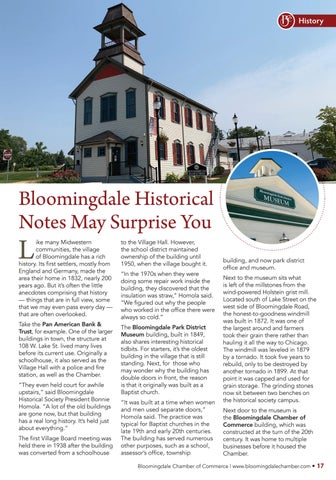History
Bloomingdale Historical Notes May Surprise You
L
ike many Midwestern communities, the village of Bloomingdale has a rich history. Its first settlers, mostly from England and Germany, made the area their home in 1832, nearly 200 years ago. But it’s often the little anecdotes comprising that history — things that are in full view, some that we may even pass every day — that are often overlooked.
to the Village Hall. However, the school district maintained ownership of the building until 1950, when the village bought it.
Take the Pan American Bank & Trust, for example. One of the larger buildings in town, the structure at 108 W. Lake St. lived many lives before its current use. Originally a schoolhouse, it also served as the Village Hall with a police and fire station, as well as the Chamber.
The Bloomingdale Park District Museum building, built in 1849, also shares interesting historical tidbits. For starters, it’s the oldest building in the village that is still standing. Next, for those who may wonder why the building has double doors in front, the reason is that it originally was built as a Baptist church.
“They even held court for awhile upstairs,” said Bloomingdale Historical Society President Bonnie Homola. “A lot of the old buildings are gone now, but that building has a real long history. It’s held just about everything.” The first Village Board meeting was held there in 1938 after the building was converted from a schoolhouse
“In the 1970s when they were doing some repair work inside the building, they discovered that the insulation was straw,” Homola said. “We figured out why the people who worked in the office there were always so cold.”
“It was built at a time when women and men used separate doors,” Homola said. The practice was typical for Baptist churches in the late 19th and early 20th centuries. The building has served numerous other purposes, such as a school, assessor’s office, township
building, and now park district office and museum. Next to the museum sits what is left of the millstones from the wind-powered Holstein grist mill. Located south of Lake Street on the west side of Bloomingdale Road, the honest-to-goodness windmill was built in 1872. It was one of the largest around and farmers took their grain there rather than hauling it all the way to Chicago. The windmill was leveled in 1879 by a tornado. It took five years to rebuild, only to be destroyed by another tornado in 1899. At that point it was capped and used for grain storage. The grinding stones now sit between two benches on the historical society campus. Next door to the museum is the Bloomingdale Chamber of Commerce building, which was constructed at the turn of the 20th century. It was home to multiple businesses before it housed the Chamber.
Bloomingdale Chamber of Commerce | www.bloomingdalechamber.com •
17












